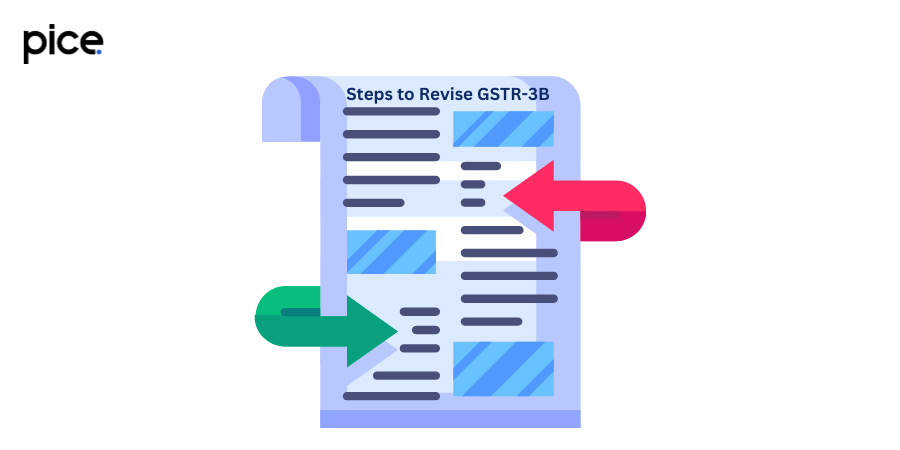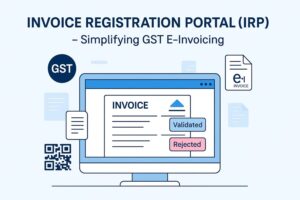GSTR-3B Revision can be possible?
- 21 Aug 24
- 18 mins

GSTR-3B Revision can be possible?
- What is the Advisory of Revised GSTR 3B Re-filing?
- What are the Major Challenges Faced by Taxpayers in GSTR 3B Form Re-filing?
- Steps to Revise GSTR-3B
- GSTR 3B Correction after Filing of Return: Is it Possible?
- Input Tax Credit (ITC) Corrections
- Revision of Returns and Resetting the Details in GSTR 3B: Both are Different Things
- Types of Mistakes in GSTR-3B and How to Rectify GSTR-3B?
- Conclusion
Key Takeaways
- Revised GSTR 3B re-filing guidelines help taxpayers correct errors without penalties.
- Corrections to GSTR 3B must be made in subsequent returns or the annual GSTR-9.
- The maximum late fee for GSTR 3B is capped at Rs. 10,000 per return period.
- Timely corrections and proper documentation ensure GST compliance and avoid penalties.
- Using the GST portal's enhanced features simplifies the re-filing and correction process.
GSTR 3B is a monthly self-declaration return that GST taxpayers need to file. Accurate filing is crucial, as it ensures compliance and avoids unnecessary penalties.
What is the Advisory of Revised GSTR 3B Re-filing?

The advisory on revised GSTR 3B re-filing is a set of guidelines issued by the GST authorities to help taxpayers correct any errors in their previously submitted GSTR 3B returns. This advisory is designed to provide clarity and streamline the process of re-filing, making it easier for taxpayers to rectify mistakes without facing undue penalties.
Definition and Purpose
The advisory outlines the steps and procedures that taxpayers should follow to revise their GSTR 3B returns. The main purpose is to ensure that taxpayers can amend their returns accurately and efficiently, thereby maintaining compliance with GST regulations. This helps in preventing discrepancies in tax filings and ensures that the correct tax liabilities are reported and paid.
Recent Updates and Changes
Recently, there have been updates to the GSTR 3B re-filing process aimed at simplifying it further. These changes include:
- Clearer Guidelines: The advisory now provides more detailed instructions on how to identify and correct errors in the returns.
- Improved Portal Functionality: Enhancements to the GST portal have been made to support the revised filing process, reducing technical glitches and downtime.
- Flexible Deadlines: In some cases, the deadlines for re-filing have been adjusted to give taxpayers more time to make corrections without incurring penalties.
- Increased Transparency: The advisory includes more transparent communication from the GST authorities, helping taxpayers understand their obligations and the consequences of non-compliance.
Key Benefits of Revised GSTR 3B Form Re-filing
Re-filing the GSTR 3B form, especially with the recent revisions, offers several key benefits to taxpayers. These advantages are designed to enhance the accuracy, compliance, and efficiency of the GST filing process. Here are some of the most significant benefits:
- Improved Accuracy
The revised GSTR 3B re-filing process allows taxpayers to correct any errors made in their initial filings. This leads to more accurate records, which are crucial for both compliance and financial management. By ensuring that the reported data is accurate, businesses can avoid future discrepancies and audits.
- Reduced Penalties
One of the primary benefits of the revised form is the reduction in penalties. The ability to correct mistakes without facing immediate penalties is a significant relief for many taxpayers. This flexibility helps businesses maintain compliance without the fear of punitive fines for honest mistakes.
- Enhanced Compliance
Re-filing promotes better compliance with GST regulations. When taxpayers have the opportunity to review and correct their returns, they are more likely to adhere to the rules and guidelines set by the GST authorities. This leads to a more transparent and accountable tax system.
- Streamlined Process
The revisions to the GSTR 3B form and the re-filing process have made it more streamlined and user-friendly. Clear guidelines and improved portal functionality reduce the complexity of filing returns, making it easier for taxpayers to follow the required steps and submit accurate returns.
- Opportunity for Rectification
Revised GSTR 3B re-filing offers taxpayers a chance to rectify mistakes related to input tax credit claims, tax calculations, and other critical areas. This opportunity helps businesses maintain proper financial records and ensures that they do not miss out on legitimate tax credits.
- Better Cash Flow Management
By allowing corrections and reducing penalties, the revised GSTR 3B re-filing process helps businesses manage their cash flow more effectively. Avoiding hefty fines and interest charges means that more funds are available for operational and strategic needs.
- Increased Transparency
The revised process encourages transparency in tax filings. When taxpayers are given a clear framework for correcting errors, it builds trust in the tax system and promotes a culture of compliance and openness.
- Ease of Use
The enhancements to the GST portal and the detailed advisory make the re-filing process more accessible. This ease of use is particularly beneficial for small and medium-sized enterprises (SMEs) that may not have extensive resources to dedicate to tax compliance.
- Encourages Timely Filing
Knowing that errors can be corrected without immediate penalties encourages more taxpayers to file their returns on time. This leads to a more efficient and timely collection of taxes by the authorities.
- Support for Businesses
Overall, the revised GSTR 3B re-filing process supports businesses by providing them with the tools and flexibility needed to comply with GST regulations. It acknowledges that mistakes can happen and offers a practical solution to address them.
What are the Major Challenges Faced by Taxpayers in GSTR 3B Form Re-filing?

While the revised GSTR 3B form re-filing process offers several benefits, taxpayers often encounter a variety of challenges. These difficulties can complicate the re-filing process and create obstacles to achieving accurate and timely compliance. Here are some of the major challenges faced by taxpayers:
- Common Errors
Despite the availability of guidelines, taxpayers frequently make errors in their GSTR 3B filings. These errors can range from simple data entry mistakes to more complex issues such as incorrect tax calculations or misreporting of input tax credits. Identifying and correcting these errors can be time-consuming and frustrating.
- Technical Issues
Technical problems with the GST portal are a significant challenge. Taxpayers often experience server downtimes, slow response times, and other technical glitches that can hinder the re-filing process. These issues can lead to delays and increase the likelihood of missing deadlines, thereby incurring penalties.
- Understanding the New Form
The revisions to the GSTR 3B form and the updated guidelines can be confusing, especially for those who are not well-versed in tax laws. The new format and additional requirements can overwhelm taxpayers, leading to mistakes and delays in filing.
- Lack of Adequate Guidance
While the advisory provides a framework for re-filing, taxpayers sometimes find the instructions insufficient or unclear. Without adequate guidance, it can be challenging to navigate the re-filing process, especially for complex tax scenarios.
- Document Management
Proper document management is crucial for accurate re-filing, but it can be a daunting task. Taxpayers need to ensure that all necessary documents, such as invoices and previous return filings, are readily available and accurately recorded. Mismanagement of documents can lead to errors and discrepancies in the re-filed returns.
- Time Constraints
Re-filing requires careful review and correction of the initial return, which can be time-consuming. For businesses with limited resources, dedicating sufficient time to this process can be challenging. Time constraints may lead to rushed filings and further mistakes.
- Fear of Penalties
The fear of incurring penalties can create significant stress for taxpayers. While the revised process aims to reduce penalties, the uncertainty around the potential financial consequences of errors can be daunting. This fear may lead to reluctance in making necessary corrections or delays in re-filing.
- Complex Tax Scenarios
For businesses with complex tax scenarios, such as multiple transactions, interstate sales, and varying tax rates, the re-filing process can be particularly challenging. Accurately reporting all details and ensuring compliance with the updated guidelines requires a high level of expertise and attention to detail.
- Lack of Professional Support
Small and medium-sized enterprises (SMEs) often lack access to professional tax advisors. Without expert guidance, these businesses may struggle to understand the intricacies of the revised GSTR 3B form and the re-filing process. This lack of support can lead to errors and non-compliance.
- Changes in Tax Regulations
Frequent changes in tax regulations and updates to the GST portal can add to the complexity of the re-filing process. Keeping up with these changes and understanding their implications for GSTR 3B filings can be a significant challenge for taxpayers.
- Coordination Issues
For larger businesses, coordinating among various departments to gather the necessary information for re-filing can be a logistical challenge. Ensuring that all relevant data is accurately compiled and reported requires effective communication and collaboration within the organization.
- Data Accuracy
Maintaining accurate data across multiple systems and ensuring consistency in reporting is critical for successful re-filing. Inaccuracies in data management can lead to discrepancies in the GSTR 3B form and potential compliance issues.
Steps to Revise GSTR-3B

Revising GSTR-3B involves a systematic approach to correcting any errors made in the initial filing. Here is a step-by-step guide to help you through the process:
Step 1: Login to the GST Portal
Access the GST Portal: Visit the official GST portal at gst.gov.in.
Login: Use your GST credentials (Username and Password) to log in to your account.
Step 2: Navigate to Services
- Go to Returns Dashboard: After logging in, navigate to the 'Returns Dashboard' under the 'Services' tab.
- Select Financial Year and Return Period: Choose the appropriate financial year and the return period for which you need to revise the GSTR-3B.
Step 3: Access the Return
- Select GSTR-3B: In the Returns Dashboard, find the GSTR-3B for the selected period and click on 'Prepare Online'.
Step 4: Make the necessary corrections.
- Correct Details: Carefully review the previously submitted details. Correct any errors in the following sections:
- Taxable outward supplies
- Outward supplies attract reverse charge
- Eligible ITC
- Exempt, nil, and non-GST inward supplies
- Payment of tax
- Interest and late fee details
- Input Accurate Data: Ensure all corrections are accurate and supported by proper documentation.
Step 5: Save the Changes
- Save Progress: As you make corrections, periodically save your progress by clicking the 'Save GSTR-3B' button. This helps to prevent data loss in the event of any technical issues.
Step 6: Review and Verify
- Review Corrections: Before submitting the revised return, thoroughly review all the changes made to ensure accuracy.
- Verify Details: Cross-check the corrected entries with your records, such as invoices and bank statements, to ensure consistency.
Step 7: Submit the Revised Return
- Submit GSTR-3B: Once you are satisfied with the corrections, submit the revised GSTR-3B by clicking the 'Submit' button.
- File Return: After submission, file the return using the 'File GSTR-3B with DSC/EVC' button. Use either the Digital Signature Certificate (DSC) or Electronic Verification Code (EVC) for authentication.
Step 8: Make Payment (if required)
- Check Payment Summary: If there are additional tax liabilities due to the corrections, check the payment summary.
- Make Payment: Pay any outstanding amount through the available payment modes on the GST portal.
Step 9: Download Acknowledgement
- Download Filing Summary: After successfully filing the revised GSTR-3B, download the filing summary and acknowledgement for your records.
- Keep Documentation: Maintain copies of the revised return and all supporting documents for future reference and audits.
Required Documents
To facilitate the revision process, ensure you have the following documents handy:
- Previous GSTR-3B filings
- Purchase and sales invoices
- Bank statements
- Input tax credit (ITC) records
- Any other relevant financial documents
Penalty and Late Fees for GSTR-3B

Overview of Penalties
Penalties for late filing of GSTR-3B can be quite steep, including late fees and interest on the outstanding tax amount. It's crucial to be aware of these to avoid extra costs. Here’s a breakdown of the penalties:
Late Filing Fees:
- Nil Return Filers: Rs. 20 per day (Rs. 10 each for CGST and SGST).
- Other Taxpayers: Rs. 50 per day (Rs. 25 each for CGST and SGST).
- Maximum Late Fee: Capped at Rs. 5,000 for CGST and Rs. 5,000 for SGST, totaling Rs. 10,000 per return period.
Interest on Outstanding Tax:
- Interest Rate: 18% per annum on the outstanding tax amount.
- Calculation: Multiply the outstanding tax by the daily interest rate (18% per annum/365 days) and the number of days the payment is delayed.
How to Avoid Late Fees?
To avoid late fees, always file your returns on time. Here are some tips to help ensure timely submissions:
- Set Reminders
- Use calendar reminders or automated alerts to keep track of filing deadlines.
- Mark the due dates on your calendar as recurring events.
Maintain accurate records
- Keep detailed and up-to-date records of all transactions.
- Organize documents such as invoices, purchase records, and sales receipts to facilitate quick and accurate filing.
Plan Ahead
- Allocate time each month specifically for preparing and filing GSTR-3B.
- Avoid a last-minute rush by starting the preparation well before the due date.
Use professional help
- Consider hiring a tax professional or accountant to manage your GST filings.
- Utilize GST software that offers automated filing features and deadline reminders.
Stay Informed
Keep abreast of any changes in GST regulations and filing deadlines.
Follow updates from the GST Council or GST portal to be aware of any announcements regarding extensions or waivers.
GSTR 3B Correction after Filing of Return: Is it Possible?
Yes, it is possible to correct GSTR-3B after filing, but there are specific procedures and limitations to be aware of. Here’s a detailed guide on how corrections can be made:
Correction Process
Subsequent Month Adjustments
- If you realize that an error has been made after filing GSTR-3B, you cannot directly amend the filed return. However, you can adjust the error in the subsequent month's GSTR-3B return.
- For instance, if you discover an error in the January GSTR-3B after submission, you can rectify it in the February GSTR-3B.
Additional Liability
- If the error results in an additional tax liability, you need to pay the extra tax amount along with applicable interest in the next month's return.
- Use Table 3.1 of GSTR-3B to declare the additional tax liability.
Input Tax Credit (ITC) Corrections

If the error involves claiming excess or short ITC, you can correct it in the subsequent month's return.
Adjust the ITC in Table 4 of the next GSTR-3B return.
Utilizing the Annual Return (GSTR-9)
- You can make corrections for the entire financial year in the GSTR-9 annual return.
- This allows you to reconcile and correct discrepancies that were not addressed during the monthly filings.
Limitations and Restrictions
No Direct Amendment
Direct amendments to the GSTR-3B return are not allowed. Corrections must be made through subsequent returns or the annual return.
Time Limit for Corrections
Corrections to GSTR-3B can only be made until the earlier of the following:
- The date of filing the annual return (GSTR-9) for the financial year.
- The due date for filing the GSTR-3B return is September of the following financial year.
Interest and Penalties
- If the correction involves paying additional tax, interest will be applicable from the original due date of the GSTR-3B return until the date of payment.
- Ensure timely corrections to avoid accumulating interest and potential penalties.
Detailed Documentation
- Maintain comprehensive records of all corrections made in subsequent returns.
- Documentation is crucial for audit purposes and to substantiate the corrections.
Steps to Correct GSTR-3B
- Identify the Error
Review your GSTR-3B return and identify any discrepancies or errors.
- Calculate the Impact
Determine the financial impact of the error, including any additional tax liability or ITC adjustments.
- Prepare for Adjustment
Prepare the necessary documentation to support your corrections.
Adjust the figures in the subsequent GSTR-3B return.
- File the Correction
Enter the corrected figures in the appropriate sections of the subsequent GSTR-3B return.
Pay any additional tax liability along with interest, if applicable.
- Keep Records
Retain copies of the original return, correction documentation, and the subsequent return where the correction was made.
This documentation is vital for future reference and audit compliance
Revision of Returns and Resetting the Details in GSTR 3B: Both are Different Things
When dealing with GSTR-3B filings, it's important to understand that revising returns and resetting the details are two different processes, each serving unique purposes.
Revision of Return
Revision involves correcting errors in previously filed returns by making adjustments in subsequent returns.
- Correcting in Subsequent Returns: Errors in a filed GSTR-3B are corrected in the next month's return by adjusting figures.
- Tax Liability and ITC Adjustments: Additional tax liabilities and ITC adjustments are made in the subsequent return.
- Annual Return (GSTR-9): Yearly corrections can be reconciled in the annual return, GSTR-9.
- Documentation: Maintain records of all corrections for audit purposes.
- Example: If you overstate sales in April, reduce the sales figure in May to correct the error.
Resetting the Details
Resetting involves erasing the entered data in an ongoing GSTR-3B return before submission.
- Before Submission: Resetting of details can only be done before the return is submitted to clear all data and start fresh.
- Erasing Data: This option clears all entered details, allowing re-entry of correct information.
- Not for Submitted Returns: Once submitted, returns cannot be reset; corrections must be made through revisions.
- Example: If you realize significant errors while filling May GSTR-3B, use the reset option to clear entries and re-enter accurate data.
Types of Mistakes in GSTR-3B and How to Rectify GSTR-3B?

Filing GSTR-3B accurately is crucial for compliance with GST regulations. However, mistakes can happen. Understanding the common types of errors and knowing how to rectify them is essential for taxpayers. Here are some common mistakes in GSTR-3B and how to correct them:
Types of Mistakes
Incorrect Invoice Details
- Entering wrong invoice numbers, dates, or values.
Wrong Tax Calculations
- Miscalculating the tax amount payable or the input tax credit (ITC) claimed.
Incorrect ITC Claims
- Claiming ITC on ineligible goods or services.
Mismatched Tax Liability
- Discrepancies between reported sales and tax liability.
Missing Transactions
- Omitting certain sales or purchase transactions.
Errors in B2B and B2C Sales Reporting
Misreporting business-to-business (B2B) and business-to-consumer (B2C) sales.
How to Rectify GSTR-3B?
Identify the Error
- Review Returns: Regularly review your filed returns to identify discrepancies or mistakes.
- Reconcile Records: Compare your GST returns with your accounting records and invoices.
Correct in Subsequent Returns
- Adjust in Next Month’s Return: Correct the mistake in the next month’s GSTR-3B return.
Example: If you overstated sales in April, reduce the sales figure in May.
- Declare Additional Liability: If the error results in additional tax liability, declare and pay the extra tax in the subsequent return.
- Example: Use Table 3.1 to report additional tax payable.
Input Tax Credit Adjustments
- Adjust ITC: Correct ITC claims in the next return by adjusting the figures in Table 4.
- Example: If you claimed excess ITC in April, reduce the ITC claim in May.
Use the Annual Return (GSTR-9)
- Year-End Reconciliation: Use the annual return to reconcile and correct errors for the entire financial year.
- Example: If multiple months have discrepancies, correct them cumulatively in GSTR-9.
Pay Interest and Late Fees
- Calculate Interest: If additional tax is payable, calculate interest from the original due date to the payment date at 18% per annum.
- Example: Use the formula: Outstanding Tax × (18/100) ÷ 365 × Days of Delay.
- Pay Late Fees: If applicable, pay any late fees to avoid further penalties.
- Example: Rs. 50 per day (Rs. 25 each for CGST and SGST).
Keep Detailed Records
- Documentation: Maintain records of all corrections, payments, and reconciliations for audit purposes.
- Example: Keep copies of filed returns, correction notes, and payment receipts.
Conclusion
The revised GSTR 3B form re-filing process offers several benefits, including improved accuracy and reduced penalties. However, it also presents challenges, such as common errors and technical issues. By understanding the steps involved and being aware of the penalties, registered taxpayers can navigate this process more effectively.
💡Learn more about how our Pice can help you make all your important business payments, like supplier and vendor payments, rent, GST, & utility, from one single dashboard with your credit card. Request a demo now.
FAQs
What is the Advisory of Revised GSTR 3B Re-filing?
GSTR 3B: Correction after Submission of Return Possible?
What is the maximum late fee for GSTR 3B?
How Do I Correct My GSTR 3B Mistakes After Filing?
Identify the error and its impact on your tax liability or ITC claims.
Adjust the figures in the subsequent month’s GSTR-3B return.
If additional tax is due, pay it along with applicable interest.
Use the annual return (GSTR-9) for comprehensive corrections across the financial year.
Maintain detailed records of all corrections for future reference and audits.
 By
By 

















